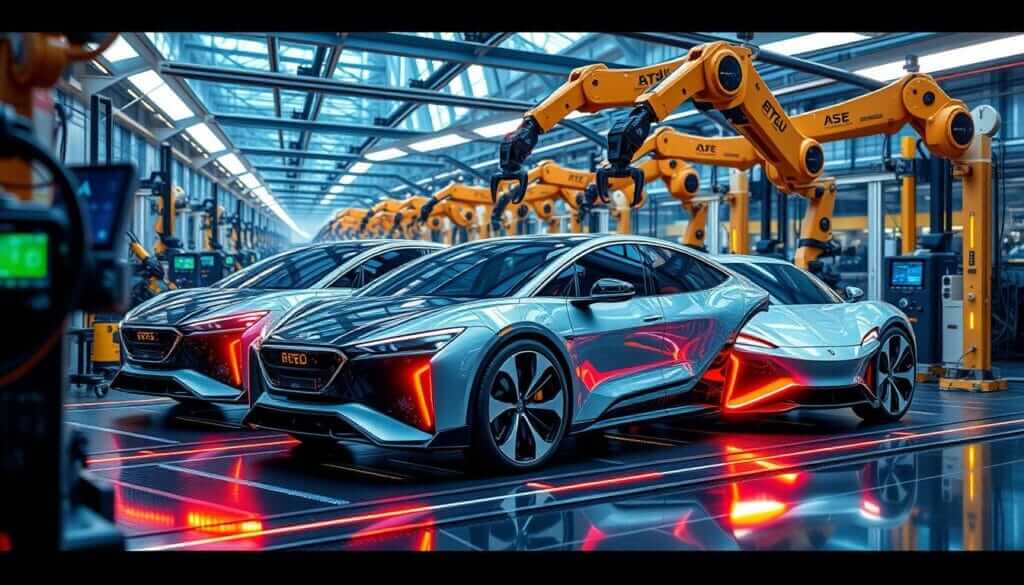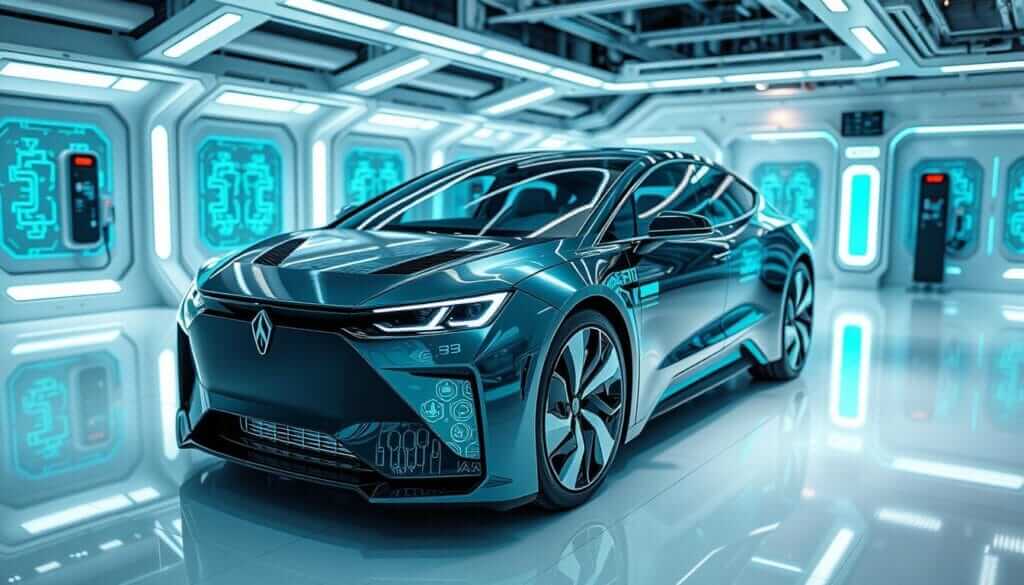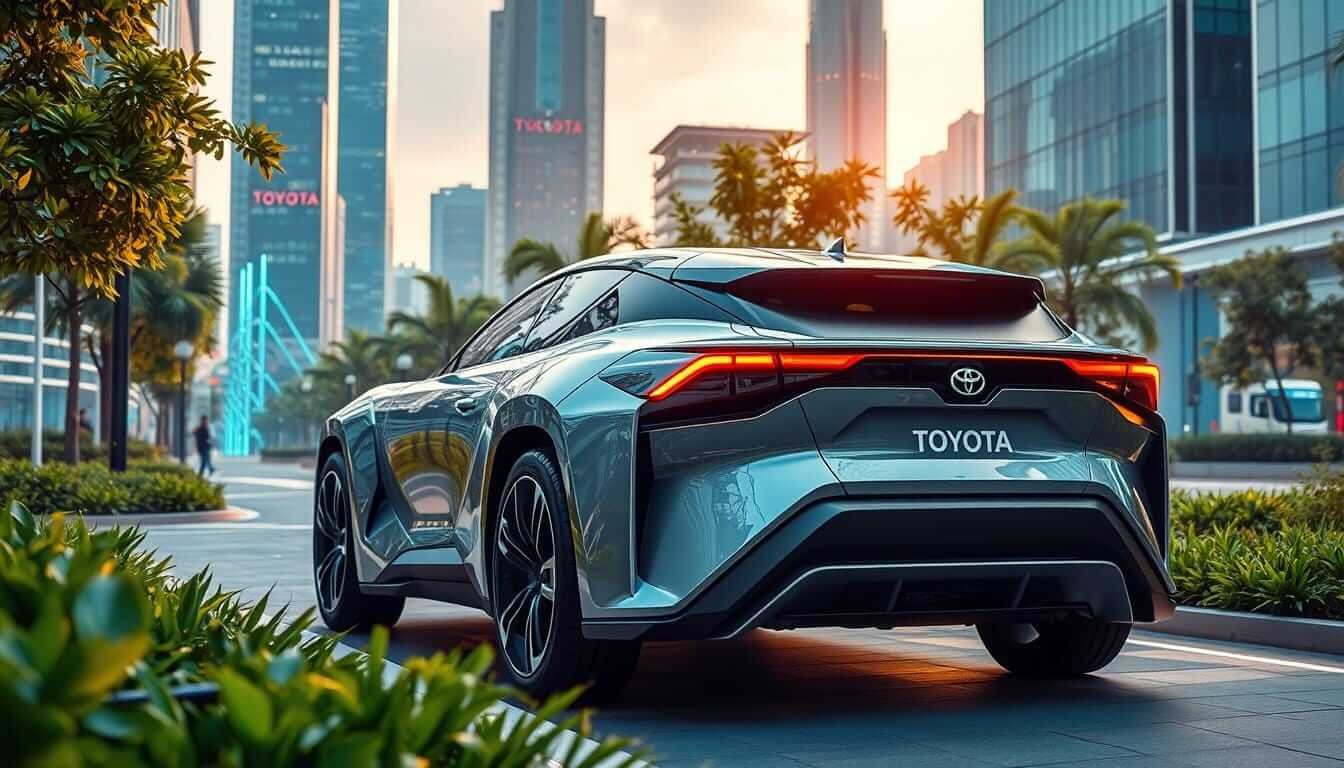Modern Toyota: Best Experience Innovation and Excellence 2025
When you enter the Toyota world, you’re not just buying a car. You’re starting a journey of innovation, sustainability, and excellence. This giant in the automotive industry leads the way, breaking new ground and changing the game. They focus on electric air mobility and new production systems, showing their dedication to progress.
Toyota’s success comes from a culture of always getting better. They use the Toyota Production System (TPS) to cut waste and make cars faster and better. This system makes sure every step in making cars is perfect and efficient.
But Toyota doesn’t stop at making cars. They’re exploring new areas, like flying cars and even space travel. Their work with Joby Aviation is making flying cars a reality, changing how we travel and connect with each other.
Exploring Toyota’s technology and commitment to green mobility is truly inspiring. They’re making electric cars and solutions for everyone, making the future of travel available now. Toyota’s goal is to make life better for people everywhere, today.
Table of Contents
Toyota’s Journey into Electric Air Mobility
Toyota is known for its innovative cars and now it’s exploring electric air mobility. It’s teaming up with Joby Aviation to change how we travel in cities.
Partnership with Joby Aviation
Toyota is investing $894 million in Joby Aviation. This shows its commitment to green flying. It believes electric air mobility will change the game.
Toyota is adding $500 million to its initial $394 million investment. This extra money will help Joby get its planes ready for the skies. It shows they both want to make flying in cities better.
Future of Urban Air Transportation
Joby’s planes can fly fast and carry people in style. They plan to start flying people in cities by 2025. This could make traveling easier and greener.
Recently, Joby’s plane flew in Japan. This was a big step for Toyota and Joby. It showed they’re making progress in electric air travel.
Sustainable Aviation Solutions
Toyota is diving into electric air mobility for more than just tech. It’s about making flying better for the planet. By backing Joby’s planes, Toyota is leading the charge to zero-emission flying.
Toyota and Joby are working together for a greener future. They’re making flying in cities better and more efficient. Their work could change how we travel in exciting ways.
Revolutionary Advances in Toyota Production System
At the heart of Toyota’s success is the Toyota Production System (TPS). This system has changed the car industry worldwide. It’s based on Jidoka, which adds a human touch to automation, and Just-in-Time, making only what’s needed when it’s needed.
The story of TPS starts with Sakichi Toyoda, who invented the automatic loom. His son, Kiichiro, then developed the Just-in-Time idea. Together, they mixed technology and lean manufacturing, leading to Toyota’s high efficiency and quality.
TPS focuses on constant improvement, or Kaizen. Toyota makes small changes every day to get better. It also values standardization, keeping quality and consistency high.
| TPS Principles | Key Objectives |
|---|---|
| Just-in-Time (JIT) | Produce only what is needed, when it is needed, to reduce waste |
| Jidoka | Combine automation with human judgment to detect and address defects immediately |
| Continuous Improvement (Kaizen) | Implement small, incremental changes to enhance efficiency and quality |
| Standardization | Establish consistent processes and procedures for efficiency and quality |
The Toyota Production System has inspired many industries, from electronics to aerospace. It has made Toyota a leader in innovation and quality.
“The Toyota Production System has not been simply adopted; it has been adapted, evolved, and refined by organizations around the world to fit their unique needs and cultures.”
Toyota keeps improving manufacturing, showing the power of continuous improvement and innovation. It’s all about delivering value to customers.
Modern Toyota: Leading the Zero-Emission Revolution
Toyota is leading the way in the zero-emission revolution. It’s known for its commitment to sustainability. The company is working hard to reduce its environmental impact through carbon neutrality and sustainable manufacturing.
Carbon Neutral Manufacturing
Toyota aims to be carbon neutral in Europe by 2040. It’s developing zero-emission solutions, like a hydrogen fuel cell Hilux. The company is also using clean manufacturing methods, like HVO100 fuel and zero-CO2 paint shops.
Sustainable Energy Solutions
Toyota is investing in next-generation battery technology. By 2026, it plans to introduce zero-emission vehicles with a 1,000 km (620 miles) range. This is thanks to better efficiency, aerodynamics, and cost reduction.
Environmental Impact Reduction
Toyota is focusing on climate change. Over half of its R&D staff and expenses are now on advanced development fields. This shows the company’s commitment to sustainable manufacturing and reducing its environmental impact.
Toyota is a leader in zero-emission vehicles, carbon neutrality, and sustainable manufacturing. It’s innovating and adapting to meet market needs. Toyota is making the automotive industry more sustainable and environmentally conscious.
| Metric | Value |
|---|---|
| R&D Staff Shift to Advanced Development | Over 50% |
| R&D Expenses Shift to Advanced Development | Approximately 50% |
| BEV Factory Planned Production by 2030 | 1.7 million out of 3.5 million units globally |
| Fuel Cell Market Projection by 2030 | Around 5 trillion yen per year |
| Fuel Cell Vehicle Sales Target by 2030 | 100,000 units |
| Next-Generation BEV Cruising Range Target by 2026 | 1,000 km (620 miles) |
| Next-Generation BEV Cost Reduction Target | Around 20% |
Innovation in Artificial Intelligence and Robotics
Toyota is leading the way in changing the car industry with AI and robotics. The Toyota Research Institute (TRI) is at the heart of this change. There, experts are working on making robots learn new skills fast and improving AI for safer driving.
Toyota is focusing on making cars drive themselves better. They’re testing these systems on public roads in Brussels, Belgium. This use of AI could make driving safer and more reliable in the future.
The Human Support Robot (HSR) is another key project for Toyota. It’s a robot that can help people with many tasks. This shows Toyota’s goal to make life better with technology.
| Toyota’s AI and Robotics Initiatives | Key Highlights |
|---|---|
| Toyota Research Institute (TRI) | Developing advanced methods for teaching robots new skills quickly and enhancing AI-assisted driving systems |
| Automated Driving Tests in Europe | Conducting trials of automated driving systems on public roads in Brussels, Belgium |
| Human Support Robot (HSR) | An open innovation platform for exploring the possibilities of robotics in assisting individuals with various tasks |
| Toyota-Gideon Partnership | Collaboration to simplify automated vehicle systems through standardization, reduced deployment times, and increased flexibility, adaptability, and scalability |
| Woven City | A 175-acre fully autonomous community being built in Japan, featuring e-pallet autonomous delivery vehicles and a connected ecosystem powered by clean energy |
Toyota is not just innovating in cars. They’re also working with Gideon to make automated systems better. This partnership aims to make transporting goods easier and more efficient in many industries.
Toyota is also building Woven City, a futuristic community in Japan. It will be powered by clean energy and have over 2,000 residents. Toyota’s e-pallets will deliver goods, showing their vision for a green future.
Toyota is also focusing on education and community. They’re working with Discovery Education to teach students about safe driving and vehicle safety. This aims to inspire the next generation to create a better future.

Toyota is leading the way in AI and robotics in the car industry. Their work is changing how we drive and shaping a future where technology meets human needs. This shows the exciting possibilities that await us.
Toyota’s Commitment to Paralympic Sports
At Toyota, we are deeply committed to fostering inclusive mobility solutions. We empower Paralympic athletes to reach new heights. Our partnership with the Paralympic Games goes beyond providing transportation. It’s about developing innovative adaptive technologies that enhance athletes’ performance and independence.
Inclusive Mobility Solutions
As a proud mobility partner of the Paralympic Games, Toyota ensures all participants have access to reliable transportation. Our fleet of vehicles is designed with the unique needs of Paralympic athletes in mind. They offer features like wheelchair accessibility, adjustable seating, and intuitive controls.
Adaptive Technology Development
In collaboration with Paralympic athletes, Toyota’s engineers are pioneering cutting-edge adaptive technologies. They develop custom-designed prosthetics, mobility aids, and specialized sports equipment. Our team is constantly pushing the boundaries of what’s possible, creating solutions that can truly transform lives.
Paralympic Partnership Success
Toyota’s commitment to the Paralympic movement has been widely recognized. The company played a pivotal role in the recent success of the games. Our “Start Your Impossible” campaign has inspired millions, showcasing the incredible achievements of Paralympic athletes and promoting inclusivity, resilience, and determination.
Looking ahead, Toyota remains steadfast in its support of the Paralympic Games. We plan to provide sustainable mobility solutions for the upcoming Paris 2024 event. By continuing to invest in adaptive technology and fostering meaningful partnerships, we are committed to empowering individuals with diverse abilities. We aim to create a more inclusive world through the power of sport.
Next-Generation Battery Technology
Toyota is leading the way in electric vehicle batteries for a greener future. Their goal is to make battery electric vehicles (BEVs) that are both efficient and emotionally appealing.
Toyota is making big strides in battery technology. They aim to cut the cost of their new batteries by 20% for the high-performance version. For the more affordable version, they hope to reduce costs by 40% and boost the range by 20%.
The company is setting even higher targets. They want to increase the range by 10% and lower costs by 10% for the high-performance version. They also aim for a quick charge time of 20 minutes or less. For all-solid-state batteries, they aim for a 20% better range and a 10-minute quick charge.
Toyota is set to change the game in sustainable energy storage. They aim to make BEVs that are both powerful and affordable. Their focus on advanced battery technology shows their dedication to a greener future.
“Toyota is at the forefront of developing advanced electric vehicle batteries that will power the future of sustainable mobility.”

Toyota is also exploring new technologies to improve their BEVs. They’re studying rocket technology to reduce drag. They’re also working to make production faster and cheaper by half.
Toyota’s drive for innovation and sustainability will lead the way in electric vehicle batteries and advanced battery technology. They’re set to bring the next big leap in sustainable energy storage to the world of transportation.
Space Exploration and Toyota’s Lunar Cruiser
Toyota is leading the charge in space exploration. They’re working with JAXA to create the Lunar Cruiser. This lunar vehicle will help NASA’s Artemis Program.
JAXA Collaboration
Toyota is exploring new mobility beyond Earth. They’re teaming up with JAXA to make a top-notch lunar vehicle. This vehicle will tackle the Moon’s tough terrain.
Moon Mission Technology
The Lunar Cruiser is built for the Moon’s harsh conditions. It has a pressurized cabin for astronauts to work and live safely. It uses advanced fuel cell and solar technology.
This vehicle can travel up to 1,000 km on a single hydrogen tank fill. Over 42 days, it can cover 10,000 km.
| Specification | Value |
|---|---|
| Launch Date | 2029 |
| Total Cruising Range | Approximately 6,200 miles |
| Pressurized Living Area | 13 cubic meters |
| Vehicle Size | 6.0m long, 5.2m wide, 3.8m tall |
| Lunar Night Temperature Range | -170°C to 120°C |
| Gravity on the Moon | One-sixth of Earth’s gravity |
Space Innovation Transfer
Toyota’s Lunar Cruiser is more than a Moon mission. It’s about bringing space tech to Earth. The fuel cell and solar energy could make our transportation cleaner and greener.
Toyota’s Lunar Cruiser shows what’s possible with teamwork and innovation. It’s a big step towards a sustainable future in space and on Earth.
Digital Transformation in Manufacturing
Toyota has changed the game in manufacturing by using digital technologies. They’ve made smart factories that use digital processes. Their factories now have IoT devices that help monitor and collect data in real-time.
This helps make production more efficient. Toyota also uses advanced analytics and AI for predictive maintenance. This cuts down on downtime and keeps operations running smoothly.
They’ve also introduced collaborative robots, or “cobots,” to work alongside humans. This boosts precision and productivity in their tasks. Toyota is also using digital twin technology to improve its manufacturing.
These digital twins let them test and refine their processes virtually. This move helps reduce their carbon footprint and makes their operations more sustainable. Toyota is always looking to innovate, exploring new tech like quantum computing and blockchain. They’re committed to keeping their workforce skilled for the digital future of manufacturing.
FAQ
What areas is Toyota committed to innovating and excelling in?
Toyota is working hard in many areas. This includes electric air mobility, zero-emission vehicles, and artificial intelligence. They’re also into robotics, Paralympic sports, and battery tech. Plus, they’re exploring space and making manufacturing digital.
What is Toyota’s partnership with Joby Aviation focused on?
Toyota is teaming up with Joby Aviation for electric air mobility. They want to change urban air travel with green tech. Their goal is to make zero-emission planes for city skies.
What are the two pillars of the Toyota Production System (TPS)?
The Toyota Production System (TPS) has two main parts: Jidoka and Just-in-Time. It aims to cut waste and improve quality. TPS started with Sakichi Toyoda’s loom and Kiichiro’s Just-in-Time idea. It keeps getting better with daily improvements.
What are some of Toyota’s initiatives to achieve carbon neutrality?
Toyota wants to be carbon neutral in Europe by 2040. They’re making zero-emission trucks and using green manufacturing. This includes using HVO100 fuel and zero-CO2 paint shops.
How is Toyota advancing AI-assisted driving technology?
Toyota is making AI driving safer. They’re testing it on public roads in Europe. Their Human Support Robot (HSR) is also a research platform.
How is Toyota supporting the Paralympic Games?
Toyota is making mobility better for the Paralympic Games. They’re creating adaptive tech and working with athletes. They aim to provide green mobility for the 2024 Games in Paris.
What is Toyota’s focus in developing new battery technology?
Toyota is working on new batteries for cars. They want to make electric vehicles that are fun and efficient. Their goal is to create emotional connections with customers.
What is Toyota’s collaboration with JAXA focused on?
Toyota is teaming up with JAXA for the Lunar Cruiser. They’re helping NASA’s Artemis Program. This shows Toyota’s push to explore beyond Earth.
How is Toyota implementing digital transformation in its manufacturing?
Toyota is using digital twins to improve its factories. This helps cut CO2 emissions and boost efficiency. They’re also making parts depots and ventilation systems digital.
Leave your rating to do our best ?
There are no reviews yet. Be the first one to write one.
